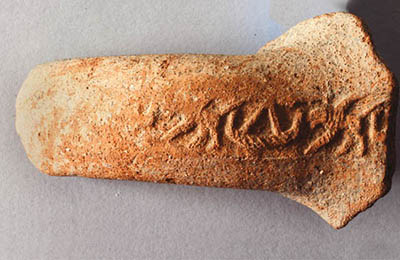
Human-Ram Deity from Sidon. With human features as well as the eyebrows, nose and horns of a ram, this painted limestone figurine represents a deity and dates to c. 1650 B.C.E. (the Middle Bronze Age). Photo: Courtesy of Claude Doumet-Serhal.
Who were the Sidonians, and what do we know about their religion?
The Sidonians were the inhabitants of ancient Sidon, a seaport on the Mediterranean Sea in modern Lebanon. Those familiar with the Biblical text will recall that Sidon was an influential, wealthy Phoenician city when the kings of Israel and Judah ruled during the Iron Age. Yet Sidon was a significant site before this period, too.
Claude Doumet-Serhal of the British Museum details recent excavations at Sidon in her article “Sidon—Canaan’s Firstborn,” published in the July/August 2017 issue of Biblical Archaeology Review. The latest archaeological discoveries shed light on Biblical Sidon and provide a window into the Sidonians’ polytheistic religion and worship practices during the Bronze and Iron Ages.
Who were the Sidonians of the Bronze Age (c. 3000–1200 B.C.E.)? They were Canaanites and shared numerous similarities, including many of the same gods, with their close neighbors in the southern Levant—who were also predominantly Canaanite.
Who were the Sidonians of the Iron Age (c. 1200–586 B.C.E.)? They were Phoenicians. Essentially, the Phoenicians were the Canaanites who survived from the Bronze Age into the Iron Age and who were not supplanted by new people groups (Philistines, Israelites, etc.). However, even though their origins were Canaanite, the Phoenicians established their own distinct culture. There was, therefore, continuity in Sidon’s population from the Bronze to the Iron Age.

Biblical Sidon is perhaps most infamously known as the birthplace of the Phoenician princess Jezebel (1 Kings 16:31), who became queen of the Israelites during King Ahab’s reign in the ninth century B.C.E. (the Iron Age). In the Bible, Jezebel is notorious for persecuting the worship of Yahweh and for demanding that the Israelites worship Baal.

Sidon’s Phoenician Temple. Archaeologists at Sidon have uncovered a 12th–11th-century B.C.E. (Iron Age) temple. One of the rooms in this temple had a bench, where offerings would have been placed, and an altar made of piled and unhewn stones, which recalls the Biblical command to make altars of uncut stones (see Exodus 20:25). In another room was a round base that likely supported a wooden pillar. Photo: Courtesy of Claude Doumet-Serhal.
Given Jezebel’s religious fervor in the Bible, one would expect to find evidence of Baal worship at Sidon. Some extraordinary discoveries from recent excavations have allowed us to partially reconstruct Sidonian religion during the Bronze and Iron Ages—showing that Baal worship at the site had deep roots.

Sidon’s Storm God. Dated to c. 1750 B.C.E. (the Middle Bronze Age), this impressed handle depicts a ship and a leonine dragon, which is the symbol of the Mesopotamian storm god Adad. Adad roughly equates with the later Phoenician storm god Baal, the worship of whom is championed by the nefarious queen Jezebel in the Bible. Photo: Courtesy of Claude Doumet-Serhal.
Notably, an impressed handle found near a Canaanite grave at the site depicts Sidon’s storm god and a ship. Dated to c. 1750 B.C.E., the handle pictures the storm god as a leonine dragon. Usually the storm god is illustrated as a striding human figure, but sometimes he is represented by one of his symbols, such as the bull or leonine dragon. Doumet-Serhal explains the significance of the handle’s iconography:
The dragon epitomizes the most fundamental ancient mythical perception of the Mesopotamian storm god. The handle displays an impression of a ship with the leonine dragon Ušumgal, the storm god Adad’s attendant, next to it. Adad (the Canaanite Hadad, the Semitic Hadda, the Hurrian Teshub, the Egyptian Resheph, the Phoenician Baal/Bel, the Sumerian Ishkur) is the Mesopotamian storm god, who has special maritime, celestial and meteorological attributes important to the well-being of sailors. Given Sidon’s position on the coast, it is not surprising that the storm god is Sidon’s most important god.
Indeed, throughout its history, the most important god at Sidon was the storm god—known during the Phoenician period as Baal or Bel.
Learn more about Biblical Sidon and Sidonian religion in Claude Doumet-Serhal’s article “Sidon—Canaan’s Firstborn” in the July/August 2017 issue of Biblical Archaeology Review.
Not a BAS Library member yet? Join the BAS Library today.
This Bible History Daily Article was first published in 2017
Related reading in Bible History Daily:
British Museum Excavations at Sidon Expose Millennia of History
The Phoenician Alphabet in Archaeology by Josephine Quinn
Did the Carthaginians Really Practice Infant Sacrifice?
The post Biblical Sidon—Jezebel’s Hometown appeared first on Biblical Archaeology Society.

0 Commentaires